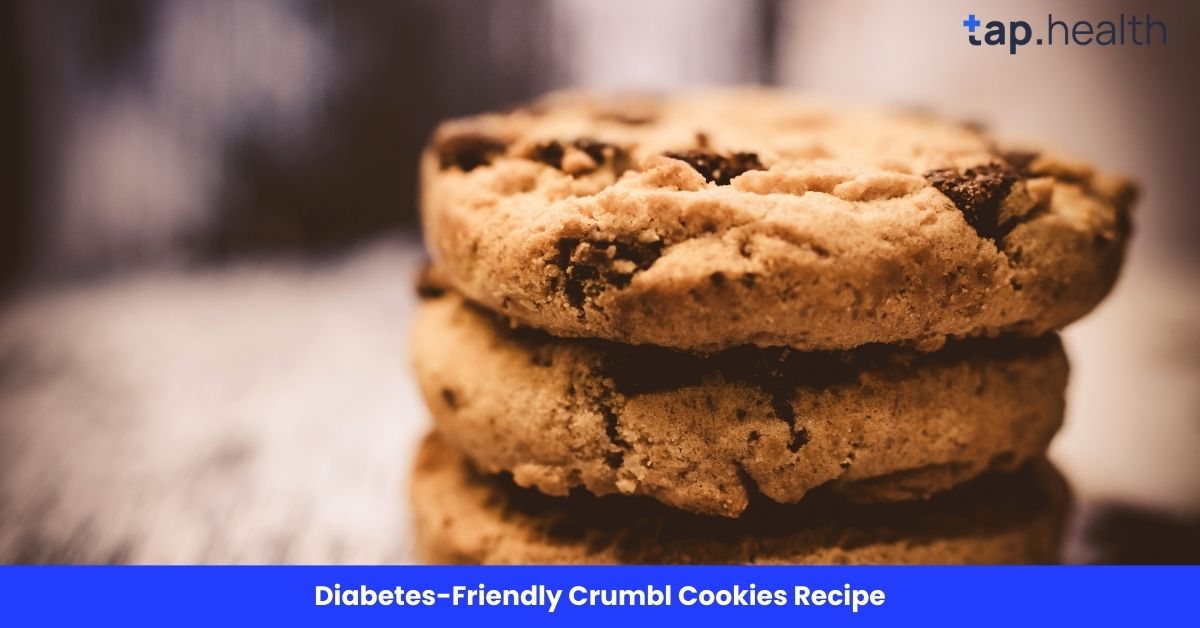For those living with diabetes, managing blood sugar levels is a top priority, especially when it comes to eating sweet treats. Traditional cookies, especially those from popular brands like Crumbl, can be loaded with sugar and carbs, which can lead to blood sugar spikes. However, that doesn’t mean you can’t enjoy delicious cookies! In fact, with the right ingredients, you can make a diabetes-friendly Crumbl cookies recipe that satisfies your cravings without jeopardizing your health.
In this article, we’ll guide you through how to make healthier Crumbl-inspired cookies that are perfect for individuals managing diabetes. We’ll talk about ingredients, tips, and tricks for making these cookies lower in sugar and carbs while still being delicious. Plus, we’ll answer all your questions about diabetes-friendly baking!
Why Crumbl Cookies Can Be a Challenge for People with Diabetes
Crumbl Cookies are well-known for their rich, indulgent flavors and large sizes. However, this indulgence comes at a price. The sugar content in Crumbl’s cookies can range from 30 to 60 grams per cookie, depending on the flavor. That’s quite a lot of sugar, especially when you consider that the American Diabetes Association recommends limiting added sugars to no more than 25 grams per day for women and 36 grams per day for men.
The Impact of High Sugar on Blood Sugar Levels
When people with diabetes consume sugary foods, the body’s blood sugar levels can rise quickly. This is because sugars and carbohydrates are broken down into glucose, which enters the bloodstream. For someone with diabetes, this can cause blood sugar spikes, making it difficult to manage the condition effectively.
But don’t worry – enjoying sweet treats is still possible! With a few simple swaps and the right approach to baking, you can make cookies that are just as delicious but won’t cause harmful spikes in your blood sugar.
How to Make a Diabetes-Friendly Crumbl Cookies Recipe
Now that we know why regular Crumbl Cookies can be challenging for people with diabetes, let’s look at how you can make a healthier version at home. By swapping out some of the high-carb, high-sugar ingredients, we can create a cookie that satisfies your sweet tooth without impacting your blood sugar too much.
Key Ingredients for a Diabetes-Friendly Cookie
To create a diabetes-friendly cookie, we need to focus on replacing sugar and refined flour, which are the primary culprits in causing blood sugar spikes. Here are some key ingredients you’ll want to use in your healthier cookie recipe:
- Sugar Substitutes
Instead of using regular sugar, opt for sugar substitutes like stevia, monk fruit, or erythritol. These natural sweeteners don’t raise blood sugar levels the way regular sugar does. They can provide the same sweetness with little to no impact on your glucose levels. Monk fruit and erythritol are particularly good choices for baking, as they don’t have an aftertaste. - Almond Flour or Coconut Flour
Traditional white flour is high in carbs, which can lead to blood sugar spikes. Instead, use almond flour or coconut flour, which are much lower in carbs and higher in fiber. These flours are also rich in healthy fats, which help slow down the absorption of sugar into the bloodstream. - Butter or Coconut Oil
Butter is commonly used in many cookie recipes, but if you want to make your cookies healthier, consider using coconut oil. Coconut oil has healthy fats that can support heart health and blood sugar control. However, if you prefer butter, use it in moderation. - Eggs
Eggs are a great source of protein and help bind ingredients together in baked goods. They are low in carbs and won’t raise your blood sugar levels. Eggs also add moisture to the dough and give the cookies a rich texture. - Vanilla Extract
For flavor, use pure vanilla extract instead of artificial vanilla flavoring, which can contain added sugars. Vanilla extract provides a subtle, natural sweetness without any added carbs. - Dark Chocolate Chips
If your Crumbl-inspired recipe calls for chocolate, choose dark chocolate chips that are at least 70% cocoa. Dark chocolate contains less sugar than milk chocolate, and the higher the cocoa percentage, the better it is for controlling blood sugar.
The Diabetes-Friendly Crumbl Cookie Recipe
Now that we’ve covered the key ingredients, let’s dive into a step-by-step diabetes-friendly Crumbl cookie recipe that you can make at home!
Ingredients
- 1 ½ cups almond flour
- ½ cup coconut flour
- ¼ cup erythritol (or sweetener of choice)
- ½ cup unsalted butter (or coconut oil for a dairy-free option)
- 2 large eggs
- 1 teaspoon vanilla extract
- ½ teaspoon baking soda
- ¼ teaspoon salt
- ½ cup dark chocolate chips (at least 70% cocoa)
Instructions
- Preheat the Oven
Preheat your oven to 350°F (175°C) and line a baking sheet with parchment paper. - Mix Dry Ingredients
In a large bowl, combine the almond flour, coconut flour, erythritol, baking soda, and salt. Stir everything together until evenly mixed. - Add Wet Ingredients
In a separate bowl, beat the eggs and vanilla extract. Then, add the butter (or coconut oil) and mix until smooth. - Combine Wet and Dry Ingredients
Slowly add the wet ingredients to the dry ingredients, stirring until well combined. The dough should be thick and slightly sticky. - Fold in the Chocolate Chips
Gently fold in the dark chocolate chips. If you want to get creative, you can also add other mix-ins like chopped nuts or unsweetened shredded coconut. - Shape the Dough
Use your hands or a cookie scoop to form the dough into small balls, about 1 to 1 ½ inches in diameter. Place them on the prepared baking sheet, leaving some space between each cookie. - Bake
Bake the cookies in the preheated oven for about 10-12 minutes, or until the edges are golden brown. Keep a close eye on them to avoid over-baking. - Cool and Enjoy
Let the cookies cool on the baking sheet for a few minutes before transferring them to a wire rack to cool completely. Enjoy your delicious, diabetes-friendly Crumbl cookies!
Tips for Making the Best Diabetes-Friendly Cookies
- Use Fresh Ingredients
Using fresh, high-quality ingredients can make a huge difference in the taste and texture of your cookies. Opt for organic almond flour and coconut flour, and always use fresh eggs and butter or coconut oil. - Adjust Sweeteners to Taste
Everyone’s preference for sweetness is different, so feel free to adjust the amount of sweetener based on your taste. If you prefer your cookies a little sweeter, you can add a bit more erythritol or monk fruit. - Add Extra Fiber
To increase the fiber content of your cookies, consider adding some flaxseed meal or chia seeds. These small seeds are rich in fiber and omega-3 fatty acids, both of which can help regulate blood sugar levels. - Experiment with Flavors
If you want to get creative, try adding different flavorings like cinnamon, nutmeg, or orange zest. These spices not only add flavor but also come with health benefits, like improving insulin sensitivity.
Real-Life Scenario
Consider someone with type 2 diabetes craving a cookie. They prepare a batch of diabetes-friendly Crumbl-style cookies at home using almond flour, stevia, and unsweetened cocoa. After enjoying one cookie, they check their blood sugar and notice only a minor increase compared to store-bought cookies. This shows that making smart substitutions allows people with diabetes to enjoy treats without major glucose spikes.
Expert Contribution
Nutritionist Dr. Ananya Kapoor explains: “Homemade, diabetes-friendly cookies are a great way to enjoy dessert while managing blood sugar. Using alternative flours and natural sweeteners reduces sugar load. Incorporating protein and fiber further minimizes blood sugar spikes. Portion control is still important—one or two cookies are enough to satisfy cravings without overloading carbohydrates.”
Recommendations Grounded in Proven Research and Facts
- Use low-glycemic sweeteners: Stevia, erythritol, or monk fruit help reduce sugar content.
- Choose whole or alternative flours: Almond, oat, or coconut flour provide fiber and protein.
- Add protein and fiber: Nuts, seeds, or protein powder improve satiety and reduce sugar spikes.
- Practice portion control: Limit to 1–2 cookies per serving.
- Monitor blood sugar: Test after eating to understand your body’s response.
Research supports that low-sugar, high-fiber, and protein-enriched baked goods help maintain more stable blood sugar levels in people with diabetes compared to traditional cookies.
Read this : Why Are Crumbl Cookies So High in Calories?
Frequently Asked Questions (FAQs) on Diabetes-Friendly Crumbl Cookies Recipe
1. Can I use regular flour in the diabetes-friendly cookie recipe?
Regular flour is higher in carbohydrates and can cause blood sugar spikes, so it’s better to use almond flour or coconut flour instead. These are lower in carbs and higher in fiber, making them a better choice for people with diabetes.
2. Can I make the cookies without butter?
Yes, you can substitute butter with coconut oil or even a dairy-free margarine to make the cookies dairy-free. Coconut oil also provides healthy fats, which can help stabilize blood sugar.
3. How can I store the cookies?
Store the cookies in an airtight container at room temperature for up to 5 days. If you want to keep them for longer, you can freeze them for up to 3 months. Just make sure to let them cool completely before storing or freezing.
4. Can I make these cookies vegan?
Yes! To make the recipe vegan, simply substitute the eggs with a flaxseed egg (1 tablespoon flaxseed meal + 3 tablespoons water, let sit for 5 minutes). Also, use coconut oil instead of butter.
5. Are these cookies safe for people with Type 1 diabetes?
Yes, these cookies are much lower in sugar and carbs than traditional cookies, making them a safer choice for people with Type 1 diabetes. However, it’s always important to monitor blood sugar levels after eating to see how your body reacts.
Conclusion
Making diabetes-friendly Crumbl cookies at home is a fantastic way to enjoy a sweet treat while still managing your blood sugar levels. By using healthier ingredients like almond flour, sugar substitutes, and dark chocolate, you can create a cookie that is both delicious and mindful of your health needs. With a little creativity and the right substitutions, you can continue enjoying your favorite sweet treats without the worry of blood sugar spikes.



